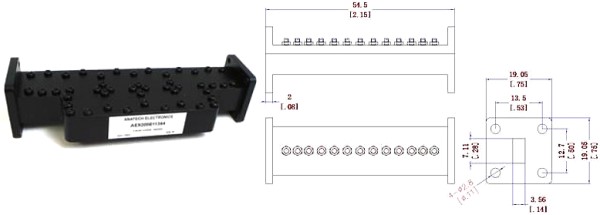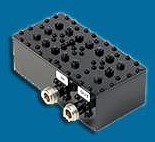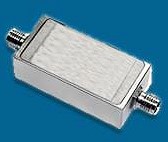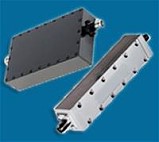
Press Release Archives:
2025 |
2024 |
2023 |
2022 |
2021
2020 |
2019
Content is copyright of company represented. Page format, custom text and
images are RF Cafe copyright - do not distribute. Note: Beginning
March 2025, posting of press releases will cost $100 each for non-advertisers.

Sam Benzacar of Anatech Electronics, an RF and microwave filter company, has published
his September 2021 newsletter that features his short op-ed entitled "5G: Will Millimeter
Waves Be High Enough?," where he notes the technical difficulties being
experienced with components and operational environments in the mm-wave realm,
and that life in the THz spectrum will be even more challenging - perhaps even
impossible for general use. As we know from
Friis equation,
electromagnetic power levels drop proportional to the square of distance (6 dB
per doubled distance), but in the THz region
atmospheric
absorption comes into play as physical molecules resonate at specific
wavelengths, further decreasing received power. Sam also presents some relevant industry
news items as well.
A Word from Sam Benzacar
5G: Will Millimeter Waves Be High Enough?
 By Sam Benzacar By Sam Benzacar
Even though wireless carriers are just now rolling out millimeter-wave networks,
the industry is already looking toward 6G and the use of frequencies well above
100 GHz and incredibly enough even into the terahertz region. Logic dictates that
if it's already difficult to overcome the limitations of the current frequencies
up to 40 GHz, operating at much higher frequencies will be all but impossible, or
so it would seem. For example, a full wavelength at 100 GHz is 3 mm and a minuscule
0.3 mm at 10 THz. So, theoretically, if immense challenges can be overcome, entire
systems could be constructed in fractions of an inch.
Researchers throughout the world are already exploring how to make this happen,
and they have great plans for it. Despite the technical technological difficulties
that will be encountered, the terahertz region, defined as 300 GHz to 10 THz, offers
unique benefits primarily because of extraordinary narrow beamwidths that will result
from the use of active phase-array, beam steerable antennas that would make signals
highly resistant to interference and extremely difficult to jam, which is why Department
of Defense already uses frequencies high in the millimeter-wave spectrum for intersatellite
communication. The virtually unlimited amounts of available spectrum would also
make it possible to achieve data rates of a blistering of 1 Tb/s (1 million Mb/s),
1000 times faster than 5G.
I may be naïve, but I find it difficult to believe that speeds like this would
be of use to most people because even millimeter-wave networks, once fully deployed,
will allow us to download two-hour movies in a few seconds. However, when the need
for terahertz operation appears, presumably at least a decade from today, there
will surely be applications that can benefit from it. The most frequently mentioned
include high-definition holographic gaming, high-speed wireless data distribution
in data centers, wireless cognition, remote sensing, and very precise positioning
and location.
As an aside, even though it's generally assumed that atmospheric absorption increases
with frequency, it does not do so in a linear fashion. That is, at millimeter-wave
frequencies and higher, the resonant frequencies of oxygen, hydrogen, and other
gases in the atmosphere result in levels of electromagnetic energy absorption that
vary with frequency. And although much of the spectrum between 600 and 800 GHz suffers
massive attenuation of 100 to 200 dB/km, over a distance of 100 m this amounts to
only 10 or 20 dB, which also happens to be the typical coverage of a small cell,
so it might be a tolerable level.
Suffice it to say that if there is a need, technology will provide an answer;
the question is whether it will actually need to.
Anatech Electronics has been providing standard and custom RF and microwave filters
and other filter-based components to solve interference problems for utilities,
oil and gas companies, and organization with similar requirements for more than
30 years, and we can solve yours as well. So, reach out to us with your most challenging
problems at (973) 442-7272 or visit our website at
anatechelectronics.com.
Qualcomm Sets New Benchmark for 5G Data Rates
 By any yardstick, deployment
of 5G wireless infrastructure is booming. The CTIA reports that the industry spent
$30 billion in networks last year, a 5-year high and the third year of increased
capital expenditures. And in the past five years, wireless carriers have spent nearly
$140 billion for a total investment of more than $600 billion, not including spectrum
acquired at auction. In the last two years, more cell sites have been added than
the previous 7 years combined. The research group IDTechEx predicts that by 2031
45 million cells will have been deployed, primarily for millimeter-wave frequencies. By any yardstick, deployment
of 5G wireless infrastructure is booming. The CTIA reports that the industry spent
$30 billion in networks last year, a 5-year high and the third year of increased
capital expenditures. And in the past five years, wireless carriers have spent nearly
$140 billion for a total investment of more than $600 billion, not including spectrum
acquired at auction. In the last two years, more cell sites have been added than
the previous 7 years combined. The research group IDTechEx predicts that by 2031
45 million cells will have been deployed, primarily for millimeter-wave frequencies.
Air Force Unleashes Massive EW Program
 The Air Force is about
to launch what it calls Project Kaiju, which is a $150 million program that focuses
on cognitive electronic warfare, artificial intelligence, and advanced systems integration.
In EW terms, this is an extremely large contract and reflects the fact that America's
fighter aircraft are expected to be operating in environments that are heavily defended
by integrated air-defense systems. Both Russia and China have demonstrated these
capabilities that without equally advanced countermeasures could thwart the best
efforts of allied forces in the future. The program calls for high levels of autonomy
and extensive use of machine learning to automate the process of threat detection,
characterization, and response. It also aims to integrate multiple types of sensors
within a single system, such as EO/IR as well as RF. The Air Force is about
to launch what it calls Project Kaiju, which is a $150 million program that focuses
on cognitive electronic warfare, artificial intelligence, and advanced systems integration.
In EW terms, this is an extremely large contract and reflects the fact that America's
fighter aircraft are expected to be operating in environments that are heavily defended
by integrated air-defense systems. Both Russia and China have demonstrated these
capabilities that without equally advanced countermeasures could thwart the best
efforts of allied forces in the future. The program calls for high levels of autonomy
and extensive use of machine learning to automate the process of threat detection,
characterization, and response. It also aims to integrate multiple types of sensors
within a single system, such as EO/IR as well as RF.
DARPA Wants to Tame the Wild West Satcom Environment
 With the enormous growth
of low-earth-orbit satellites, DARPA is seeking to collaborate with the private
sector to develop seamless optical communications links between commercial and defense
spacecraft. According to the program's manager, the current lack of communications
link standards has resulted in a stove-piped domain in which commercial and government
satellites cannot communicate with each other. The program, called Space-Based Adaptive
Communications Node, hopes to change this with the end result being a cohesive communications
approach that provides benefits for both private industry and DoD. With the enormous growth
of low-earth-orbit satellites, DARPA is seeking to collaborate with the private
sector to develop seamless optical communications links between commercial and defense
spacecraft. According to the program's manager, the current lack of communications
link standards has resulted in a stove-piped domain in which commercial and government
satellites cannot communicate with each other. The program, called Space-Based Adaptive
Communications Node, hopes to change this with the end result being a cohesive communications
approach that provides benefits for both private industry and DoD.
China Claims to Have Quantum Radar, Again
 Researchers in China have
gone on record as saying they have developed a quantum radar that can detect stealth
aircraft. Quantum radar is the Holy Grail of researchers, is extraordinarily complicated,
and some believe it may not even be possible. However, the researchers at Tsingua
University explained in her a paper appearing in the Chinese Journal of Radars that
even though it is a formidable undertaking if achievable quantum radar could make
all types of stealth countermeasures useless. The researchers also claimed to have
tested a scaled-down version of such a device in the university's laboratory that
increased the chances of a stealth aircraft being detected by up to 95%. Researchers in China have
gone on record as saying they have developed a quantum radar that can detect stealth
aircraft. Quantum radar is the Holy Grail of researchers, is extraordinarily complicated,
and some believe it may not even be possible. However, the researchers at Tsingua
University explained in her a paper appearing in the Chinese Journal of Radars that
even though it is a formidable undertaking if achievable quantum radar could make
all types of stealth countermeasures useless. The researchers also claimed to have
tested a scaled-down version of such a device in the university's laboratory that
increased the chances of a stealth aircraft being detected by up to 95%.
Getting Ready for 5G:
Anatech Electronics introduce New Ka band 30.5 GHz Waveguide Band Pass Filter.
Featuring a center frequency of 30.5 GHz, a bandwidth of 1000 MHz, an Insertion
Loss 1 dB Max, and a Power Handling is 20 watts.

Anatech Electronics Introduces a New Line of Suspended Stripline and
Waveguide Type RF Filters
Check out Our Filter Products



Cavity Band Pass Filters
LC Band Pass Filters Cavity Bandstop/Notch Filter
About Anatech Electronics
Anatech Electronics, Inc. (AEI) specializes in the design and manufacture of
standard and custom RF and microwave filters and other passive components and subsystems
employed in commercial, industrial, and aerospace and applications. Products are
available from an operating frequency range of 10 kHz to 30 GHz and include cavity,
ceramic, crystal, LC, and surface acoustic wave (SAW), as well as power combiners/dividers,
duplexers and diplexers, directional couplers, terminations, attenuators, circulators,
EMI filters, and lightning arrestors. The company's custom products and capabilities
are available at www.anatechelectronics.com.
Contact:
Anatech Electronics, Inc. 70 Outwater Lane Garfield, NJ 07026 (973)
772-4242
sales@anatechelectronics.com
Posted September 29, 2021
|









 By Sam Benzacar
By Sam Benzacar By any yardstick, deployment
of 5G wireless infrastructure is booming. The CTIA reports that the industry spent
$30 billion in networks last year, a 5-year high and the third year of increased
capital expenditures. And in the past five years, wireless carriers have spent nearly
$140 billion for a total investment of more than $600 billion, not including spectrum
acquired at auction. In the last two years, more cell sites have been added than
the previous 7 years combined. The research group IDTechEx predicts that by 2031
45 million cells will have been deployed, primarily for millimeter-wave frequencies.
By any yardstick, deployment
of 5G wireless infrastructure is booming. The CTIA reports that the industry spent
$30 billion in networks last year, a 5-year high and the third year of increased
capital expenditures. And in the past five years, wireless carriers have spent nearly
$140 billion for a total investment of more than $600 billion, not including spectrum
acquired at auction. In the last two years, more cell sites have been added than
the previous 7 years combined. The research group IDTechEx predicts that by 2031
45 million cells will have been deployed, primarily for millimeter-wave frequencies.
 The Air Force is about
to launch what it calls Project Kaiju, which is a $150 million program that focuses
on cognitive electronic warfare, artificial intelligence, and advanced systems integration.
In EW terms, this is an extremely large contract and reflects the fact that America's
fighter aircraft are expected to be operating in environments that are heavily defended
by integrated air-defense systems. Both Russia and China have demonstrated these
capabilities that without equally advanced countermeasures could thwart the best
efforts of allied forces in the future. The program calls for high levels of autonomy
and extensive use of machine learning to automate the process of threat detection,
characterization, and response. It also aims to integrate multiple types of sensors
within a single system, such as EO/IR as well as RF.
The Air Force is about
to launch what it calls Project Kaiju, which is a $150 million program that focuses
on cognitive electronic warfare, artificial intelligence, and advanced systems integration.
In EW terms, this is an extremely large contract and reflects the fact that America's
fighter aircraft are expected to be operating in environments that are heavily defended
by integrated air-defense systems. Both Russia and China have demonstrated these
capabilities that without equally advanced countermeasures could thwart the best
efforts of allied forces in the future. The program calls for high levels of autonomy
and extensive use of machine learning to automate the process of threat detection,
characterization, and response. It also aims to integrate multiple types of sensors
within a single system, such as EO/IR as well as RF.  With the enormous growth
of low-earth-orbit satellites, DARPA is seeking to collaborate with the private
sector to develop seamless optical communications links between commercial and defense
spacecraft. According to the program's manager, the current lack of communications
link standards has resulted in a stove-piped domain in which commercial and government
satellites cannot communicate with each other. The program, called Space-Based Adaptive
Communications Node, hopes to change this with the end result being a cohesive communications
approach that provides benefits for both private industry and DoD.
With the enormous growth
of low-earth-orbit satellites, DARPA is seeking to collaborate with the private
sector to develop seamless optical communications links between commercial and defense
spacecraft. According to the program's manager, the current lack of communications
link standards has resulted in a stove-piped domain in which commercial and government
satellites cannot communicate with each other. The program, called Space-Based Adaptive
Communications Node, hopes to change this with the end result being a cohesive communications
approach that provides benefits for both private industry and DoD.  Researchers in China have
gone on record as saying they have developed a quantum radar that can detect stealth
aircraft. Quantum radar is the Holy Grail of researchers, is extraordinarily complicated,
and some believe it may not even be possible. However, the researchers at Tsingua
University explained in her a paper appearing in the Chinese Journal of Radars that
even though it is a formidable undertaking if achievable quantum radar could make
all types of stealth countermeasures useless. The researchers also claimed to have
tested a scaled-down version of such a device in the university's laboratory that
increased the chances of a stealth aircraft being detected by up to 95%.
Researchers in China have
gone on record as saying they have developed a quantum radar that can detect stealth
aircraft. Quantum radar is the Holy Grail of researchers, is extraordinarily complicated,
and some believe it may not even be possible. However, the researchers at Tsingua
University explained in her a paper appearing in the Chinese Journal of Radars that
even though it is a formidable undertaking if achievable quantum radar could make
all types of stealth countermeasures useless. The researchers also claimed to have
tested a scaled-down version of such a device in the university's laboratory that
increased the chances of a stealth aircraft being detected by up to 95%. 





